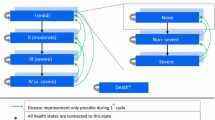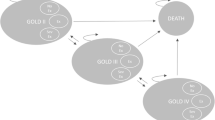Abstract
Background: Healthcare costs for chronic obstructive pulmonary disease (COPD) have continued to increase with the increasing prevalence of the disease. New interventions that can reduce the medical costs of COPD are needed. Tiotropium bromide, a once-daily inhaled anticholinergic, has been evaluated in patients with COPD enrolled in two 1-year randomised, double-blind, placebo-controlled (usual care) trials which showed the drug reduced exacerbations and improved spirometry, dyspnoea, and health status.
Objective: To retrospectively assess the direct costs of medical care for COPD in a US healthcare setting for patients treated with tiotropium in addition to usual care compared with usual care alone over a 1-year timeframe. The study was based on resource utilisation in the two previously described trials.
Methods: Resource utilisation and clinical data were prospectively collected for the two 1-year, randomised, double-blind trials of tiotropium plus usual care versus usual care alone (placebo) in 921 patients with COPD. Usual care was defined as any medication for COPD used prior to the trial except anticholinergics and long-acting β-adrenoceptor agonists. Medical care resource utilisation was recorded at every scheduled visit in each trial. Mean total costs were calculated retrospectively by combining the resources utilised with the appropriate unit costs (1999 US dollars), excluding study drug (tiotropium) costs.
Results: Compared with usual care, patients receiving tiotropium in addition to usual care had significantly fewer COPD exacerbations (20% decrease), hospitalisations (44% reduction) and hospital days (50% reduction). Utilisation of resources other than hospitalisation did not differ between study groups. As a consequence, patients receiving tiotropium had significantly lower mean per- patient costs of hospitalisation compared with patients receiving usual care alone (tiotropium $US1738 ± $US259; placebo $US2793 ± $US453). The mean difference in the cost of hospitalisation (resulting from all causes, including COPD) between treatment groups was -$US1056 (95% CI -$US2078, -$US34), and the difference in total healthcare costs (excluding study drug acquisition cost) was -$US1043 (95% CI -$US2136, $US48) in favour of tiotropium. The cost of hospital admissions accounted for 48% of the total direct medical costs in this trial.
Conclusions: As hospitalisation is a large contributor to the cost of COPD, the addition of tiotropium to usual care therapy may have the potential to reduce the economic burden of COPD in a US healthcare setting. However, as our study did not consider the acquisition cost of tiotropium, further economic evaluation including this cost is needed to address whether tiotropium is cost saving compared with usual care (placebo).




Similar content being viewed by others
Notes
The use of trade names is for product identification purposes only and does not imply endorsement.
References
Pauwels RA, Buist AS, Calverley PM, et al. Global strategy for the diagnosis, management, and prevention of chronic obstructive pulmonary disease: NHLBIIWHO Global Initiative for Chronic Obstructive Lung Disease (GOLD) workshop summary. Am J Respir Crit Care Med 2001; 163: 1256–76
Murray CJ, Lopez AD. The global burden of disease. Vol. 1. Cambridge (MA): Harvard University Press, 1996: 325–96
National Center for Health Statistics. Monthly vital statistics report 1979–1998. Rockville (MD): NCHS; 1999
Strassels SA, Smith DH, Sullivan SD, et al. The costs of treating COPD in the United States. Chest 2001; 119: 344–52
Dewan NA, Rafique S, Kanwar B, et al. Acute exacerbation of COPD: factors associated with poor treatment outcome. Chest 2000; 117: 662–71
Disse B, Speck GA, Rominger KL, et al. Tiotropium (Spiriva): rrechanistical considerations and clinical profile in obstructive lung disease. Life Sci 1999; 64: 457–64
Casaburi R, Mahler DA, Jones PA, et al. A long-term evaluation of once-daily inhaled tiotropium in chronic obstructive pulmonary disease. Eur Respir J 2002; 19: 217–24
Chodosh S, Flanders JS, Kesten S, et al. Effective delivery of particles with the HandiHaler dry powder inhalation system over a range of chronic obstructive pulmonary disease severity. J Aerosol Med 2001; 14: 309–15
Standards for the diagnosis and care of patients with chronic obstructive pulmonary disease: American Thoracic Society. Am J Respir Crit Care Med 1995; 152: S77–121
Mahler DA, Weinberg DH, Wells CK, et al. Baseline dyspnoea index and transitional dyspnoea index: the measurement of dyspnoea. Chest 1984; 85: 751–8
Ware Jr JE, Sherbourne CD. The MOS 36-item short-form health survey (SF-36): I. Conceptual framework and item selection. Med Care 1992; 30: 473–83
Jones PW, Quirk FR, Baveystock CM, et al. A self-complete measure of health status for chronic airflow limitation: the St. George’s Respiratory Questionnaire. Am Rev Respir Dis 1992; 145: 1321–7
Wilson L, Devine EB, So K. Direct medical costs of chronic obstructive pulmonary disease: chronic bronchitis and emphysema. Resp Med 2000; 94: 204–13
Current Procedural Terminology (CPT). American Medical Association. Chicago (IL): American Medical Association, 1999
St Anthony’s Complete Resource Based Relative Value Scale (RBRVS). Reston (VA): St Anthony Publiching Inc., 1999
Agency for Healthcare Research and Quality, Rockville (MD). Healthcare Cost and Utilization Project (HCUP) database [online]. Available from URL: http://www.ahrq.gov/datalhcup/hcup-pkt.htm [Accessed 1999 Aug 30]
SOLAS [computer program]. Version 2.0. Saugas (MA): Statistical Solutions, Ltd, 1999
Rubin DB, Schenker N. Multiple imputation in health-care databases: an overview and some applications. Stat Med 1991; 10: 585–98
Oostenbrink JB, Rutten-van Molken MP, Al MJ, et al. One year cost-effectiveness of tiotropium versus ipratropium to treat chronic obstructive pulmonary disease. ERJ 2004; 23: 241–9
Sullivan SD, Ramsey SD, Lee TA. The economic burdenof COPD. Chest 2000; 117: 55–95
Dvision of Epidemiology, National Heart, Lung and Blood Institute [online]: 1996. Available from URL: http:// www.nhlbi.nih.gov [Accessed 2003, Aug 30]
Sullivan SD, Strussels SA, Smith DH. Characterization of the costs of COPD in the US [abstract]. Eur Resp J 1996; 9 Suppl. 23: 4215
Friedman M, Serby CW, Menjoge SS, et al. Pharmacoeconomic evaluation of a combination of ipratropium plus albuterol compared with ipratropium alone and albuterol alone in COPD. Chest 1999; 115: 635–41
Benayoun S, Ernst P, Suissa S, et al. The impact of combined inhaled bronchodilator therapy in the treatment of COPD. Chest 2001; 119: 85–92
Dahl R, Greefhorst LA, NowakD, et al. Inhaled formoterol dry powder versus ipratropium bromide in chronic obstructive pulmonary disease. Am J Respir Crit Care Med 2001; 164: 778–84
Mahler DA, Donohue JF, Barbee RA, et al. Efficacy of salrreterol xinafoate in the treatment of COPD. Chest 1999; 115: 957–65
Rennard SI, Anderson W, ZuWallack R, et al. Use of a longacting inhaled beta2-adrenergic agonist, salrreterol xinafoate, in patients with chronic obstructive pulmonary disease. Am J Respir Crit Care Med 2001; 163: 1087–92
Chapman KR, Arvidsson P, Chuchalin AG, et al. The addition of salmeterol 50mg bid to anticholinergic treatment in patients with COPD: a randomized, placebo controlled trial. Can Respir J 2002; 9: 178–85
Mahler D, Wire P, Horstman D, et al. Effectiveness of fluticasone propionate and salrreterol combination delivered via the DISKUS device in the treatment of chronic obstructive pulmonary disease. Am J Respir Crit Care Med 2002; 166: 1084–91
Seemungal TA, Donaldson GC, Bhowmik A, et al. Time course and recovery of exacerbations in patients with chronic obstructive pulmonary disease. Am JRespir Crit Care Med 2000; 161: 1608–13
Wedzicha JA. Airway infection accelerates decline of lung function in chronic obstructive pulmonary disease. Am J Respir Crit Care Med 2001; 164: 1757–8
Donaldson GC, Seemungal TAR, Bhowmik A, et al. Relationship between exacerbation frequency and lung function decline in chronic obstructive pulmonary disease. Thorax 2002; 57: 846–52
Vincken W, van Noord JA, Greefhorst APM, et al. Improvement in health status in patients with COPD during one year treatment with tiotropium. Eur Respir J 2002; 19: 209–16
Ruchlin HS, Dasbach EJ. An economic overview of chronic obstructive pulmonary disease. Pharmacoeconomics 2001; 19: 623–42
Acknowledgements
S.S. Menjoge, S. Anton and S. Kesten are employees of Boehringer Ingelheim Pharmaceuticals, Inc., Ridgefield (CT), USA. The study was funded by Boehringer Ingelheim Pharmaceuticals Inc.
Author information
Authors and Affiliations
Corresponding author
Rights and permissions
About this article
Cite this article
Friedman, M., Menjoge, S.S., Anton, S.F. et al. Healthcare Costs with Tiotropium Plus Usual Care versus Usual Care Alone Following 1 Year of Treatment in Patients with Chronic Obstructive Pulmonary Disorder (COPD). PharmacoEconomics 22, 741–749 (2004). https://doi.org/10.2165/00019053-200422110-00004
Published:
Issue Date:
DOI: https://doi.org/10.2165/00019053-200422110-00004




